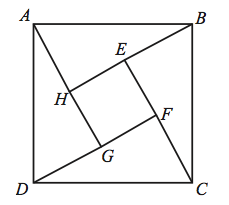Difference between revisions of "2005 AMC 10A Problems/Problem 8"
(→See Also) |
(→See Also) |
||
| Line 24: | Line 24: | ||
[[Category:Introductory Geometry Problems]] | [[Category:Introductory Geometry Problems]] | ||
[[Category:Area Problems]] | [[Category:Area Problems]] | ||
| − | + | ||
*[[2005 AMC 10A Problems]] | *[[2005 AMC 10A Problems]] | ||
| Line 30: | Line 30: | ||
*[[2005 AMC 10A Problems/Problem 9|Next Problem]] | *[[2005 AMC 10A Problems/Problem 9|Next Problem]] | ||
| + | {{MAA Notice}} | ||
Revision as of 15:16, 10 August 2017
Problem
In the figure, the length of side ![]() of square
of square ![]() is
is ![]() and
and ![]() =1. What is the area of the inner square
=1. What is the area of the inner square ![]() ?
?
![]()
Solution
We see that side ![]() , which we know is 1, is also the shorter leg of one of the four right triangles (which are congruent, I'll not prove this). So,
, which we know is 1, is also the shorter leg of one of the four right triangles (which are congruent, I'll not prove this). So, ![]() . Then
. Then ![]() , and
, and ![]() is one of the sides of the square whose area we want to find. So:
is one of the sides of the square whose area we want to find. So:
![]()
![]()
![]()
![]()
![]() So, the area of the square is
So, the area of the square is ![]() .
.
See Also
The problems on this page are copyrighted by the Mathematical Association of America's American Mathematics Competitions. 










